|
Trigonometric
functions and inverse trigonometric functions or
arc-functions
|
|
Trigonometric
functions graphs and relations
|
|
Trigonometric
(cyclometric) functions are defined as the ratios of the sides of a right
triangle containing the angle equal to the argument of the
function in radians.
|
|
Or
more generally, for real arguments, trigonometric
functions are defined in terms of the coordinates of the
terminal point Q of
the arc
(or angle) of the unit circle with the initial point at P(1,
0). |
|
|
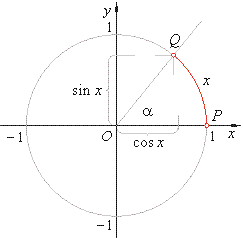 |
 |
| sin2x
+ cos2x
= 1 |
|
|
|
|
The
graph of the
sine function
|
|
The
sine function y
= sin x
is the y-coordinate
of the terminal point of the arc x
of the unit circle.
|
|
The
graph of the sine function is the sine curve or sinusoid.
|
|
In
a right-angled triangle the
sine function is equal to the ratio of the length of the side
opposite the given angle to the length of the hypotenuse. |
 |
 |
|
|
The
graph of the cosine function
|
|
The
cosine function y
= cos x
is the x-coordinate
of the terminal point of the arc x
of the unit circle. |
|
The
graph of the cosine function is the cosine curve or cosinusoid. |
|
In
a right-angled triangle the cosine function is equal to the
ratio of the length of the side adjacent the given angle to the
length of the hypotenuse. |
 |
 |
|
|
The
graph of the tangent function
|
|
The
tangent function
y
= tan x
is the ratio of the y-coordinate to
the x-coordinate
of the terminal point of the arc x
of the unit circle, or it is the ratio of the sine function to the cosine function.
|
|
In
a right-angled triangle the
tangent function is equal to the ratio of the length of the side
opposite the given angle to that of the adjacent side.
|
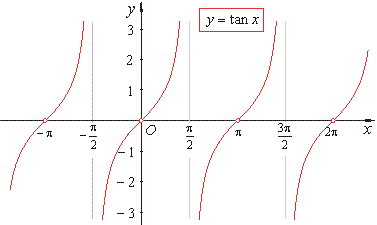 |
 |
|
|
The
graph of the cotangent function
|
|
The
cotangent function y
= cot x
is the reciprocal of the tangent function, or it is the ratio of the cosine
function to the
sine function.
|
|
In
a right-angled triangle the cotangent function is equal to the ratio of the length of the side adjacent
to the given angle to that of the side opposite it.
|
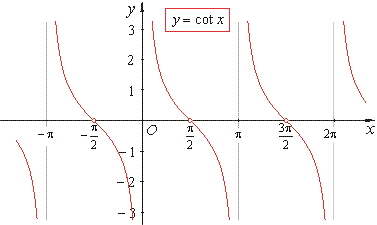 |
 |
|
|
The
graph of the cosecant function
|
|
The
cosecant function
y
= csc x
is the reciprocal of the sine function.
|
|
In
a right-angled triangle the
cosecant function is equal to the ratio of the length of the
hypotenuse to that of the side opposite to the given angle.
|
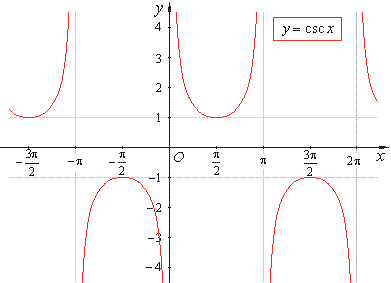 |
 |
|
|
The
graph of the secant function
|
|
The
secant function
y
= sec x
is the reciprocal of the cosine function.
|
|
In
a right-angled triangle the secant function is equal to the
ratio of the length of the hypotenuse to that of the side
adjacent to the given angle.
|
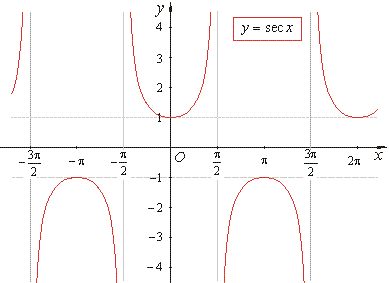 |
 |
|
|
The
graph of the function y = a
sin
(bx + c)
|
|
The trigonometric functions of this form have wide application in physics, electricity and engineering where
are used in analyzing and modeling behavior of different situations in which things follow a repeating pattern. |
|
Therefore, we need to know how the parameters
a,
b
and c
affect the form of the source sine function
y =
sin x. |
|
|
The sine
function y = a
sin
x
|
| The graph of the function
a sin x is obtained by multiplying each function value
sin x by the constant a. |
| That means, the ordinates of each point of the function
sin x should be a
times, |
| - increased if
a > 0,
- decreased if
0 < a < 1
and when
a < 1, |
| each point of the graph
will be reflected around the x-axis.
The parameter a
is called amplitude. |
 |
|
|
The sine function y = sin
bx
|
| The parameter
b
indicates the number of times function repeats itself within the period of
2p. Since there are
b
periods of the given function in
2p, then the length of its period is
P = 2p/b.
|
| The principal period
P
should satisfy identity for the periodic functions, thus |
 |
| For example, least or principal period of the function
sin 2x, |
 |
What means, its |
|
| graph
repeats twice within the period of
2p. |
| While the function |
 |
has a half of its period within the
interval of 2p, as its principal |
|
| period |
 |
as can be seen in
the figure below. |
|
 |
|
|
The sine function
y = sin
(x + c)
|
|
The parameter c
represents the value of translation of the
sin x function in the direction of the
x-axis |
| that is,
f
(x) = sin x => f
(x -
x0) = sin
(x -
c), x0 =
c. |
| For example, the graph of the function
y = sin
(x -
p/6)
is obtained by translating the
sin x function horizontally to
the right by
x =
p/6,
as shows the graph below. |
 |
|
|
The function y = a
sin
(bx
+ c)
|
|
The graph of the
sin x function repeat once while its argument passes through all the values of an interval
[x,
x + 2p] of the length
2p. |
| Therefore, the function
y = a
sin (bx + c) will repeat once while its argument
(bx + c)
passes through all |
| the values
from 0
to 2p,
that is 0
<
bx + c <
2p |
| from
where, bx
+ c > 0
=> x >
-
c/b
and bx
+ c <
2p
=> x <
-
c/b + 2p/b. |
| That means, the given function will start its period at
x = -
c/b
and end at the point x =
-
c/b + 2p/b. |
| It follows that the least or principal period of the function
y = a
sin (bx + c),
P = 2p/b.
|
| For example the function |
 |
will repeat once in the interval |
|
|
|
 |
that is |
 |
|
|
| Thus, given function will repeat once in each interval of the length
p, or
P = p, while
the initial point of the given interval is at
x = -
p/6,
as is shown in the figure below |
 |
|